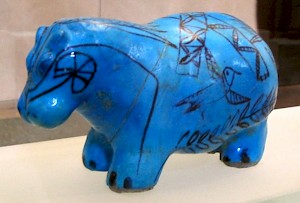Herodotus on the hippopotamus

It is usually assumed that the Greek researcher Herodotus of Halicaranassus (fifth century BCE) copied his highly inaccurate description of the hippopotamus from the Description of the Earth by Hecataeus of Miletus, but probably, neither Hecataeus nor Herodotus ever saw a hippo, although these beasts were living in the river Nile until the nineteenth century. Representing the hippopotamus, however, appears to have been impossible in Antiquity: the description by the author of Job 40.10 (or 40.15) is not very accurate either (cf. the animal on the this mosaic of the Villa Nile near Lepcis Magna).
Still, Herodotus understood that the hippo was not venerated by all Egyptians. In the Fayyum and in Thebes it certainly was, but in cities where the god Seth was identified as a destroyer, the hippopotamus was detested. In Edfu, where Seth's archenemy Horus was venerated, were representations of the killing of hippopotami. Perhaps Herodotus had a reliable witness, who told him that Egyptian opinion was divided, which made Herodotus decide to add the only description he knew, not knowing that Hecataeus' words were inaccurate.
The hippopotamus
[2.71] The hippopotamus is held sacred in the district of Papremis, but not elsewhere. This animal has four legs, cloven hoofs like an ox, a snub nose, a horse's mane and tail, conspicuous tusks, a voice like a horse's neigh, and is about the size of a very large ox. Its hide is so thick and though that when dried it can be made into spear-shafts.